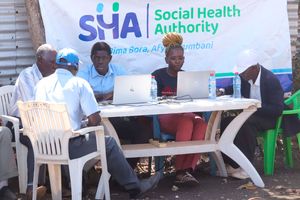Hits and misses for Ruto’s health project

President William Ruto in Kesses Constituency, Uasin Gishu County on March 9, 2025.
An election in 2022. A petition. And then two words that dismissed the petition —hot air. Tension, and then, acceptance. It was official that the Kenya Kwanza administration would steer Kenya in five years.
It was time for the Plan (or the Kenya Kwanza manifesto) to be translated into action. Top of their agenda was to resuscitate what they called the ‘dying’ Universal Health Coverage (UHC).
They had big promises for UHC in the country, and all they hoped for was to get it right. We are halfway into the new administration. Is UHC on track or not?
Community Health Promoters
Kenya's Community Health Promoter (CHP) programme has extended vital healthcare to underserved areas nationwide, with government figures showing that more than 22 million people have been screened for diabetes and 15 million for high blood pressure. The initiative has also linked thousands of women and children to health facilities.
For Alim Longor of Turkana County, the programme has been transformative. “Having a CHP supporting me was my lifeline,” she says. After nearly losing her life during childbirth, regular check-ups by her local CHP and referrals to a nearby health facility proved crucial to her recovery.
Despite these successes, the project faces significant challenges. CHPs in some counties report persistent issues with delayed payments and inadequate training.
"We used to get training a couple of years ago, but I haven't received any for a while now," explains a CHP from Turkana who serves 108 households. “For stipends from the county government, last year it took an entire year before we received anything, and even then, they only sent payment for seven months.”
This experience isn't isolated. CHPs in other counties interviewed by the Nation share similar frustrations. One worker describes how delayed payments are “crippling their functions,” while another admits they've gone so long without refresher training that they're using some kits without proper knowledge.
Social Health Insurance Fund (SHIF)
For many Kenyans, the operationalisation of the Social Health Authority (SHA) has seemed like an empty promise, as premiums and other out-of-pocket costs continue to place an extraordinary burden on millions of households. The system was rushed, and its acquisition has raised serious questions, as highlighted in the Auditor-General’s report. The launch itself was chaotic, with problems emerging immediately, leaving many to wonder whether it was truly ready to serve the people it was meant to protect.
President Ruto’s manifesto under the UDA party acknowledged that “a good health care system is something all countries struggle to achieve.” Promising a better social health scheme with the “confidence of stakeholders”, he faulted the now defunct National Health Insurance Fund (NHIF) for inefficiencies, poor responsiveness to customers and service providers and having fragmented schemes.
A scorecard dubbed “We are on Track” notes that one of the government’s achievements is a 25 percent increase in SHIF membership as more Kenyans, twice the number registered on NHIF are onboarded on the platform.
Of these, 4.2 million were transitioned from NHIF.
Dr Patrick Amoth, the director-general at the Ministry of Health, said last month that these individuals are yet to update their details on the system.
However, healthcare remains largely unaffordable, as many people continue to pay out-of-pocket due to gaps in the system. While SHIF only covers a small portion of the bill, the remaining costs often fall heavily on patients. In addition, frequent system glitches and inefficiencies make it even more difficult for individuals to access timely and appropriate care, leaving them to bear the brunt of medical costs.
It is also a burden on private and faith-based institutions, which often complain of delayed or non-payment by the government, putting their operations and services at risk.
Health Cabinet Secretary Deborah Barasa has acknowledged “teething problems” in the SHA system.
Local manufacturers
The Kenya Kwanza plan hoped to encourage more local pharmaceutical manufacturers to supply the Kenya Medical Supplies Authority (KEMSA). It promised to review tax regimes and generally reduce the cost of doing business. The grand plan was for Kenya to host a regional pharmaceutical manufacturing hub. In its mid-term report, the presidency says that the government has increased supplies to Kemsa from local suppliers by at least 63 percent.
While the Kenya Association of Manufacturers (KAM) doesn’t have this data, one local manufacturer says that more local manufacturers are now being considered as suppliers at KEMSA. There is an Open National Tender reserved for local manufacturers. Ideally, payment should be made within 90 days of service delivery. However, in some cases, 540 days, or almost a year and a half, have elapsed since delivery and payments have still not been received, the manufacturer says.
“When you take that long to pay, the local manufacturers suffer because of financing costs. We have bank loans which have high interests,” the manufacturer says.
In addition, raw materials have to be paid for within 30 to 120 days.
“Because payments are not coming through in time, some manufacturers become a bit sceptical. If we have quicker payments, then the local manufacturers will be supplying even more,” the manufacturer adds.
In the 2023 Tax Expenditure report, there was an increase in the volume of inputs for the manufacture of pharmaceutical products that were exempted from tax and the reintroduction of tax incentives that had been removed in 2020 through the Finance Act. However, this is not yet felt because while the finished product is exempt from VAT, the production aspect is not. This means that manufacturers factor into the cost of the finished product the input VAT that cannot be claimed because the finished product is exempt from VAT instead of being zero-rated for VAT (in both cases there is no VAT, but when a product is zero-rated, the input VAT can be reclaimed. When the product is exempt, the input VAT cannot be reclaimed. Thus, the product that is exempt from VAT ends up being more costly compared to the zero-rated product).
In addition, exemptions have been granted to vaccine manufacturers, but not to manufacturers of other medicines, including essential medicines.
Pharmaceutical manufacturers need to constantly upgrade their production and laboratory equipment, which is quite costly. The laboratory equipment incurs VAT which cannot be reclaimed as the final product is VAT exempt.
"There's a lot of investment that is required to keep up with the current Good Manufacturing Practices. The cost of investment is higher compared to neighbouring countries,” the manufacturer says.
Kemsa scandals
A four-word phrase sums up what the Kenya Kwanza administration promised to do to reform the country’s largest pharmaceutical procurement entity.
'Kemsa scandals must end,' they stated.
Less than a year into government, a Sh3.7 billion mosquito nets scandal tainted the promise. This led to the cancellation of the tender by the Global Fund. It also resulted in the loss of Sh168 million, which was the revenue from the procurement fees. Ms Josephine Mburu, the Principal Secretary in charge of Public Health, was sacked following the scandal. Terry Ramadhani, who was Kemsa’s chief executive officer, also became a casualty.
HEALTH SERVICE COMMISSION
The idea of a Health Service Commission was first mooted from a National Assembly’s report during the review of the 2004- 2010 Constitution from a Parliamentary Select Committee. It was reinstated as an Act of Parliament.
The HSC was to ensure that Health Human Resources (HRH) are well taken care of. Two years later, a task force was charged to share recommendations that would inform the Commission’s establishment. A report, dubbed Musyimi, was drafted. It recommended the need for the Health Ministry to focus solely on policy formulation, standards, guidelines, and regulations and not service delivery. The process of implementation stalled for years, until the Kenya Kwanza administration’s manifesto breathed a life to the idea.
While this has yet to be implemented, there is some progress. In September last year, an executive order informed the creation of a presidential task force to handle reforms on human resources for health. While it did not outright mention the reintroduction of the HSC, one of the agenda in meetings was to ensure that there is a commission. We can only hope.
State-of-art health integrated information management system
“We will procure as soon as practically possible a state-of-the-art health-integrated information management system that will enable every Kenyan to own and control access to their health records and provide them with all the information they need to access health services on their phones.”
This is an excerpt from the 2022 Kenya Kwanza manifesto. The reality of it is complex and still a mirage. While there have been efforts to digitise health records, the full integration of health records across public and private sectors remains a challenge.
Many healthcare facilities, especially in rural areas, still rely on paper-based systems, and there are issues with data privacy, system interoperability, and inconsistent internet access.
Curative vs preventive
In Kenya's shift to SHIF, a key principle was a fully tax-funded primary healthcare (PHC) system, separate from the contributory SHIF, to ensure access for all citizens, regardless of income or employment status. The emphasis was on early intervention to reduce the burden on higher levels of the health system.
The projected cost of full implementation was Sh168 billion ($1.3 billion). However, the country’s 2024-25 budget allocated Sh127 billion ($982 million) for the entire health sector and Sh6.1 billion ($47 million) for the Social Health Authority.
When TaifaCare was launched, the government allocated Sh6.1 billion to the primary healthcare fund, despite the fund requiring Sh50 billion. Similarly, Sh4.1 billion was allocated to the emergency and chronic illness fund, which needed Sh75 billion.






